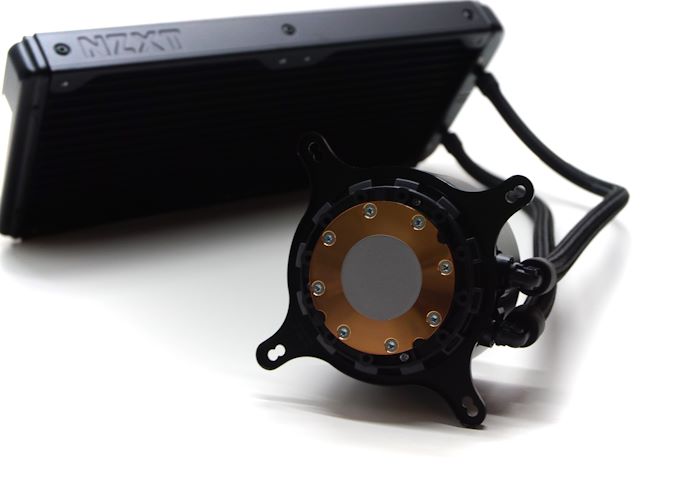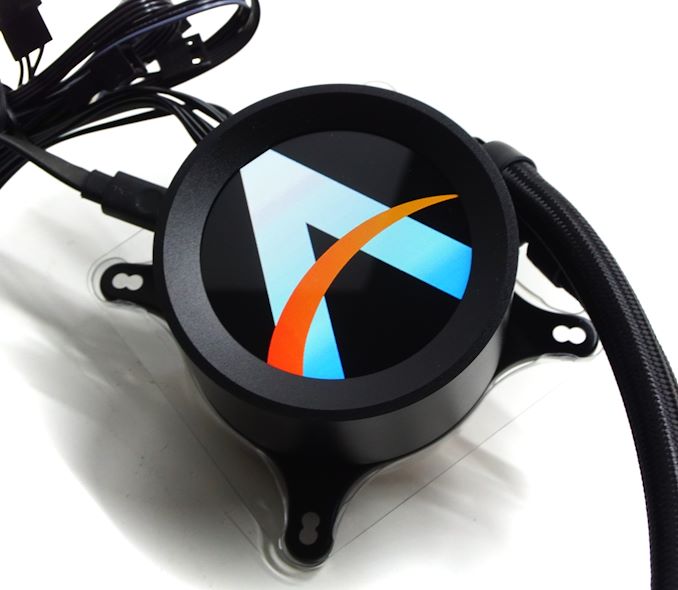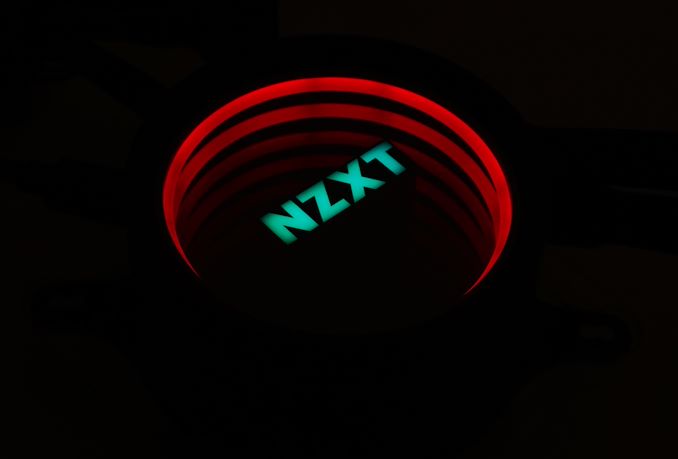The NZXT Kraken Z63 & X73 AIO Cooler Review: Shiny On Top, Solid Underneath
by E. Fylladitakis on August 19, 2020 11:00 AM ESTConclusion
NZXT is in the business of designing and marketing unique products, both in terms of features and aesthetics. The new Kraken Z-3 series is a testament to those goals, as the versatility of the LCD screen opens up nearly endless possibilities for advanced users. However, the Z-3 is a very costly cooling solution and NZXT knows that it cannot compete in the mainstream market, which is why the company also offers the simpler Kraken X-3 series as well.
The X-3 series is for all practical purposes the same as the Z-3 series, just minus the LCD screen. Other than that, the fans, radiator, and main block assembly (including the pump), are all identical between the two series. As far as aesthetics are concerned, X-3 coolers still have RGB lighting and are compatible with the company’s CAM software. And more importantly for a crowded cooler market, they retail for significantly less than the Z-3 series coolers.
Aesthetics aside, the overall cooling performance of the X73 and Z63 coolers are very good. The X73 can deliver great thermal performance, but other products outpace it in terms of noise – including NZXT’s own Z63. In fact, in some respects the X63 actually outperforms the X73 if we're looking at the performance-to-noise ratio under typical loads. So although the larger X73 can ultimately deliver slightly better thermal performance, the significantly higher noise levels makes it a dubious choice unless the expected thermal load is going to be extraordinarily high. This leaves the more balanced Z63 (and presumably the X63 as well) as the better of the coolers in most situations.
Summing things up, we find that the NZXT Kraken X73 is a competitive product with good market potential. It performs very well overall, offers a great build quality, and looks sharp. Taking into account its performance, full set of features, and software support, at $180 it is a competitively-priced product. And while we didn't get a chance to look at the smaller, $150 X63, given the common architecture of NZXT's coolers, based on what we saw with the Z63, it may be the strongest of them all.
On the other hand, the NZXT Kraken Z63 (and the whole Z-3 series) finds itself at a very niche point in the market. The LCD definitely is a cool feature, but at $250 it nearly doubles the retail price of the cooler, a gap that's a bit much for something the majority of people will glance at but a few times during its entire lifespan. It might make sense as a real-time temperature/load indicator if the PC is positioned on a desk and in such a way that the motherboard is visible at all times by the user but, still, buyers are definitely paying a hefty premium for what's ultimately an aesthetic feature.













61 Comments
View All Comments
QB - Thursday, August 20, 2020 - link
I ran my H80i for close to 8 years (not sure the exact date, but it was at least 7 for sure) and only retired it this year for an iCUE H110i RGB PRO XT. Not a single leak, and it only suffered from a minor amount of liquid permeation... If I was to guess how much liquid disappeared over the 7+ years based only on the sound of the liquid moving around the radiator, I would say it was maybe 25%. I did not "need" to retire it, but with all new gear sitting under it, I figured an all new cooler was also warranted :)QB
silencer12 - Thursday, August 20, 2020 - link
Repeat after me. You will eventually be using liquid cooling since air cooling will not be able to keep up in the future because processors will generate much more heat.Guspaz - Thursday, August 20, 2020 - link
Air cooling can handle a fully loaded 280W threadripper without trouble. Consumer chips are still at 105W. I think we’re good for a while yet. Liquid cooling does not substantially outperform air cooling until you go larger than 240mm rads, where space can become a concern.Luminar - Thursday, August 20, 2020 - link
Future processors will generate much more heat?Are you talking about Intel's processors in 2022 (if Intel still even exists)?
Unashamed_unoriginal_username_x86 - Thursday, August 20, 2020 - link
Intel isn't going to up and disappear because they lost the DIY segment, it has 10x the revenue of AMD, and a lot of market share for AMD to bite into still.Speaking of the DIY market, it's very popular to overclock there, and the biggest bottleneck outside of if it's unlocked is thermal management.
silencer12 - Thursday, August 20, 2020 - link
Yes, future processors will generate more heat. Likely, in my opinion. I am talking more than 2-4 years in the future.Intel made 71.9 billion (2019). Of course they will exist. They are coming out with their own graphics cards.
@unshamed explained the rest already for me below on market share.
PeachNCream - Friday, August 21, 2020 - link
I don't think you will see widespread need for water cooling in desktop PC hardware in the near future. Not when the average desktop CPU currently sits between 35-65W TDP with a few halo models reaching to +95W. Compute resources have to meet other targets besides more instructions per second in order to be economically viable products. That, of course, dismisses enterprise workloads in data centers where I think liquid cooling might be a more reasonable consideration and where packing as much density into a given rack while having the staffing and vendor support to handle potential liquid cooling is a fair bit more doable.silencer12 - Friday, August 21, 2020 - link
Acknowledged.Tom Sunday - Thursday, October 8, 2020 - link
I just purchased my all new prebuild PC from my local 'strip-center' tech-shop for $800 cash including a used RTX 1080 ($95) from a cryptocurrency miner since the mining days are now virtually a thing of the past. Yes...Intel has a lot of cash and more even today after just spinning off one off their subsidiaries. NVIDIA just paid $40 billion for ARM. Making CPU's? Corsair went public and looking at their "S1-document filing" made Mr. Paul (CEO) a cool $100 million with stock options. My Reality: The boys at the computers show were laughing that some highly touted AIO's now costing more then brand new older generation CPU's.They said that AIO water-cooler purchases applies to less than 20% of all customers or people coming to the show. Furthermore that the total USA motherboard market represents up to 90% of solely 'mainstream boards' between $90-$125 and which generally do not overclock. Madnu said..."For the man on the street cash is tight." I am not good with numbers and marketing and many other things so what do I know? But listening to the 'geek-team' from Bangladesh I inherently know something is not right with the hardware prices as touted on the open market. Paying $280 for a AIO? Meanwhile I am back in my basement command center listening to the Mugen-5 humming along. Playing Fallout 4 for the very first time in 'Max' settings. Today Mom is baking a strawberry pie. Life is good.Beaver M. - Friday, August 21, 2020 - link
Judged by what?AMD, whos CPUs always were running hotter/less efficient than Intel at the same manufacturing process?
Intel, who is still stuck with hot-headed 14 nm CPUs?
Dont make me laugh. Telling the future by the unique situations we have now, is pretty nonsensical.
Even in 10 year, its more likely that manufacturers will optimize their case ventilation and/or space for air coolers.
I mean, most midi cases have space for 4 to 6 more D15-size air coolers, that isnt used at all.
Its long due time for a new standard anyway. ATX is 25 years old!
And before I put some crappy AIO in my case, I rather build a water cooler myself for a few hundred bucks more.